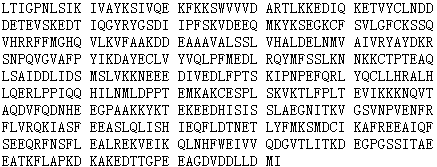Recombinant X-Ray Repair Cross Complementing 5 (XRCC5)
KARP1; KU80; KUB2; Ku86; NFIV; TLAA; Lupus Ku Autoantigen Protein P80; Nuclear factor IV; 86 kDa of Ku antigen; CTC box-binding factor 85 kDa; Thyroid-lupus autoantigen
- Product No.RPD013Mu01
- Organism SpeciesMus musculus (Mouse) Same name, Different species.
- SourceProkaryotic expression
- HostE.coli
- Endotoxin Level<1.0EU per 1µg (determined by the LAL method)
- Subcellular LocationNucleus
- Predicted Molecular Mass58.8kDa
- Accurate Molecular Mass59kDa(Analysis of differences refer to the manual)
- Residues & TagsLeu251~Ile732 with N-terminal His Tag
- Buffer FormulationPBS, pH7.4, containing 0.01% SKL, 5% Trehalose.
- TraitsFreeze-dried powder
- Purity> 95%
- Isoelectric Point5.1
-
Applications
Positive Control; Immunogen; SDS-PAGE; WB.
If bio-activity of the protein is needed, please check active protein. - Download Instruction Manual
- UOM 10µg50µg 200µg 1mg 5mg
-
FOB
US$ 182
For more details, please contact local distributors!US$ 456
For more details, please contact local distributors! US$ 912
For more details, please contact local distributors! US$ 2736
For more details, please contact local distributors! US$ 6840
For more details, please contact local distributors!
SEQUENCE of the Recombinant X-Ray Repair Cross Complementing 5 (XRCC5)

USAGE of the Recombinant X-Ray Repair Cross Complementing 5 (XRCC5)
Reconstitute in 10mM PBS (pH7.4) to a concentration of 0.1-1.0 mg/mL. Do not vortex.
STORAGE of the Recombinant X-Ray Repair Cross Complementing 5 (XRCC5)
Avoid repeated freeze/thaw cycles. Store at 2-8°C for one month. Aliquot and store at -80°C for 12 months.
STABILITY of the Recombinant X-Ray Repair Cross Complementing 5 (XRCC5)
The thermal stability is described by the loss rate. The loss rate was determined by accelerated thermal degradation test, that is, incubate the protein at 37°C for 48h, and no obvious degradation and precipitation were observed. The loss rate is less than 5% within the expiration date under appropriate storage condition.
INCREMENT SERVICES
Endotoxin Removal Kit
BCA Protein Quantification Kit
Protein Labeling Customized Service
Molecular Mass Marker for Protein
Recombinant Protein Customized Service
Monoclonal Antibody Customized Service
Polyclonal Antibody Customized Service
Protein Activity Test Experiment Service
Immunoprecipitation (IP) Experiment Service
Buffer
Endotoxin Removal Kit II
Real Time PCR Experimental Service
Spike RBD Protein (S-RBD)
Protein G
Protein A
Related products
| Catalog No. | Organism species: Mus musculus (Mouse) | Applications (RESEARCH USE ONLY!) |
| RPD013Mu01 | Recombinant X-Ray Repair Cross Complementing 5 (XRCC5) | Positive Control; Immunogen; SDS-PAGE; WB. |
| RPD013Mu02 | Recombinant X-Ray Repair Cross Complementing 5 (XRCC5) | Positive Control; Immunogen; SDS-PAGE; WB. |
| PAD013Mu01 | Polyclonal Antibody to X-Ray Repair Cross Complementing 5 (XRCC5) | WB; IHC; ICC; IP. |
| PAD013Mu02 | Polyclonal Antibody to X-Ray Repair Cross Complementing 5 (XRCC5) | WB; IHC; ICC; IP. |
| SED013Mu | ELISA Kit for X-Ray Repair Cross Complementing 5 (XRCC5) | Enzyme-linked immunosorbent assay for Antigen Detection. |
| LMD013Mu | Multiplex Assay Kit for X-Ray Repair Cross Complementing 5 (XRCC5) ,etc. by FLIA (Flow Luminescence Immunoassay) | FLIA Kit for Antigen Detection. |

